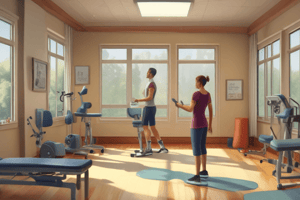Podcast
Questions and Answers
¿Cuál es el objetivo principal de la evaluación de la amplitud de movimiento (ROM)?
¿Cuál es el objetivo principal de la evaluación de la amplitud de movimiento (ROM)?
- Desarrollar planes de tratamiento
- Realizar ejercicios de fortalecimiento
- Medir la fuerza muscular
- Identificar las limitaciones del paciente (correct)
¿Cuál es el objetivo principal de la atención postoperatoria?
¿Cuál es el objetivo principal de la atención postoperatoria?
- Todos los ABOVE (correct)
- Reducir la inflamación y el dolor
- Restablecer la función y la movilidad
- Promover la cicatrización y la reparación de tejidos
¿Qué técnica de terapia manual se utiliza para reducir el dolor y la inflamación?
¿Qué técnica de terapia manual se utiliza para reducir el dolor y la inflamación?
- Mobilización articular
- Técnicas de energía muscular
- Terapia de punto de gatillo (correct)
- Masaaje
¿Qué tipo de goniómetro se utiliza para medir la inclinación o declinación de una parte del cuerpo?
¿Qué tipo de goniómetro se utiliza para medir la inclinación o declinación de una parte del cuerpo?
¿Cuál es el propósito principal de la terapia manual?
¿Cuál es el propósito principal de la terapia manual?
¿Cuál es el paso clave en la medición de la amplitud de movimiento con un goniómetro?
¿Cuál es el paso clave en la medición de la amplitud de movimiento con un goniómetro?
Flashcards are hidden until you start studying
Study Notes
Range Of Motion (ROM) Assessment
- Definition: A measurement of the amount of movement in a specific joint or body part
- Importance: Helps identify limitations, monitor progress, and develop treatment plans
- Methods:
- Goniometry: Uses a protractor-like device to measure joint angles
- Inclinometry: Measures the degree of inclination or declination of a body part
- Visual estimation: Clinician observes and estimates the ROM
- Instrumentation: Uses devices such as electrogoniometers or accelerometers
- Key points to assess:
- Active ROM (AROM): Patient moves the joint through its range
- Passive ROM (PROM): Clinician moves the joint through its range
- Resistive ROM: Measures the strength of the joint or muscle
Post-operative Care
- Goals:
- Promote healing and tissue repair
- Manage pain and inflammation
- Restore function and mobility
- Prevent complications
- Physical therapy interventions:
- Pain management: Modalities such as heat, cold, electrical stimulation, and ultrasound
- Wound care: Promote proper healing and prevent infection
- Range of motion exercises: Gradually increase mobility and strength
- Strengthening exercises: Focus on affected muscles and surrounding areas
- Education: Teach patients proper post-operative techniques and exercises
Manual Therapy
- Definition: Skilled hands-on techniques used to promote tissue repair and healing
- Techniques:
- Joint mobilization: Gentle, controlled movements to improve joint mobility
- Soft tissue mobilization: Techniques such as massage, rolling, and kneading to promote tissue repair
- Muscle energy techniques: Patient-generated contractions to improve joint mobility and strength
- Trigger point therapy: Targets specific areas of tension to reduce pain and inflammation
- Benefits:
- Improves joint mobility and range of motion
- Reduces pain and inflammation
- Enhances tissue repair and healing
- Improves muscle strength and function
Goniometria
- Definition: A measurement technique used to assess joint angles and range of motion
- Types of goniometers:
- Universal goniometer: A flexible, adjustable device used to measure various joint angles
- Inclinometer: Measures the degree of inclination or declination of a body part
- Digital goniometer: Uses electronic sensors to measure joint angles
- Procedure:
- Identify the axis of rotation: The point around which the joint moves
- Align the goniometer: Place the device along the axis of rotation
- Measure the joint angle: Record the degree of movement or angle
- Importance:
- Provides objective measurements of joint mobility and range of motion
- Helps identify limitations and monitor progress
- Informs treatment plans and interventions
Studying That Suits You
Use AI to generate personalized quizzes and flashcards to suit your learning preferences.



